

A guide to Steve Reich's music. It's rare that one says this about a contemporary composer, but it's become too easy to take Steve Reich for granted.
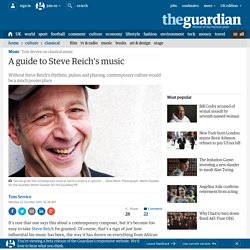
Of course, that's a sign of just how influential his music has been, the way it has drawn on everything from African drumming to concept art, and how it has influenced generations of pop, jazz and classical musicians over the last half-century. Aleatoric music - Scorepedia. Aleatoric music (also aleatory music or chance music; from the Latin word alea, meaning "dice") is music in which some element of the composition is left to chance, and/or some primary element of a composed work's realization is left to the determination of its performer(s).
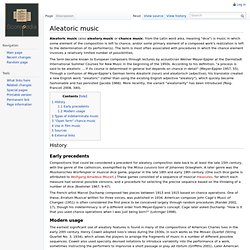
The term is most often associated with procedures in which the chance element involves a relatively limited number of possibilities. The term became known to European composers through lectures by acoustician Werner Meyer-Eppler at the Darmstadt International Summer Courses for New Music in the beginning of the 1950s. According to his definition, "a process is said to be aleatoric ... if its course is determined in general but depends on chance in detail" (Meyer-Eppler 1957, 55). Algorithmic and Generative Music. Algorithmic composition. Algorithmic composition is the technique of using algorithms to create music.
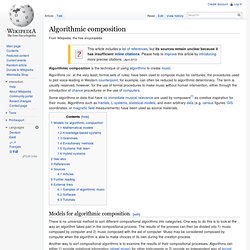
Algorithms (or, at the very least, formal sets of rules) have been used to compose music for centuries; the procedures used to plot voice-leading in Western counterpoint, for example, can often be reduced to algorithmic determinacy. The term is usually reserved, however, for the use of formal procedures to make music without human intervention, either through the introduction of chance procedures or the use of computers. Some algorithms or data that have no immediate musical relevance are used by composers[1] as creative inspiration for their music. Algorithms such as fractals, L-systems, statistical models, and even arbitrary data (e.g. census figures, GIS coordinates, or magnetic field measurements) have been used as source materials. Algorithmic composition. Algorithmic Composition (2007) Karlheinz Essl in: Cambridge Companion to Electronic Music, ed. by Nick Collins and Julio d'Escrivan Cambridge University Press 2007, p. 107-125. - ISBN-13: 978-0521688659 download...

Algorithmic Composition by Mary Simoni and Roger Dannenberg. Appendix 1: The Hidden Markov Model. Representation of a Query As shown in Figure 1, the user's query is transcribed by a pitch tracker into a form usable by MusArt.
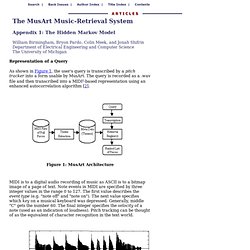
The query is recorded as a .wav file and then transcribed into a MIDI1-based representation using an enhanced autocorrelation algorithm [2]. Figure 1: MusArt Architecture MIDI is to a digital audio recording of music as ASCII is to a bitmap image of a page of text. Arvo Pärt. Arvo Pärt (Estonian pronunciation: [ˈɑrvo ˈpært]; born 11 September 1935) is an Estonian composer of classical and sacred music.[1] Since the late 1970s, Pärt has worked in a minimalist style that employs his self-invented compositional technique, tintinnabuli. His music is in part inspired by Gregorian chant. As of 2013, Pärt has been the most performed contemporary composer in the world for three years in a row.[2] Life[edit] Pärt was born in Paide, Järva County, Estonia, and was raised by his mother and stepfather in Rakvere in northern Estonia. He began to experiment with the top and bottom notes as the family's piano's middle register was damaged.[3] His first serious study came in 1954 at the Tallinn Music Middle School, but less than a year later he temporarily abandoned it to fulfill military service, playing oboe and percussion in the army band.
Brian Eno. Brian Eno (b. 1948) Albums Textures (1989) Obscure No. 3: Discreet Music – Brian Eno (1975) Brian Eno's Obscure Records Series.
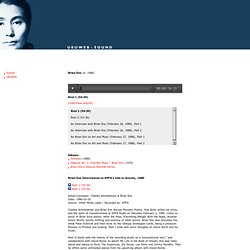
Brian Eno Imaginary Landscapes. Chart of Musical Symbols. Composer_myers_briggs.png (9759×6316) Elliott Carter. He was extremely productive in his later years, publishing more than 40 works between the ages of 90 and 100,[1] and over 20 more after he turned 100 in 2008.[2] His last work, Epigrams for piano trio, was completed on August 13, 2012.[3] Biography[edit] Elliott Cook Carter Jr. was born in Manhattan on December 11, 1908, the son of a wealthy lace importer.
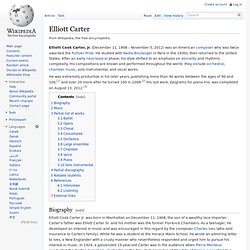
Form and Articulation in Music - Michael G. Cunningham. Gallery of Graphic Musical Notation. Here's 24 examples of unusual or graphic musical notation, from the cuneiform markings of the oldest song in the world, to the graphic notation of Stockhausen, Crumb, Cage and Eno, to the painted musical inventions of Adolph Wolfli.

Click each picture for a larger image. Key to composers of above works, arranged by row, left to right: Row 1: Bernard Rands, John Cage, Adolph Wolfli. Georg Friedrich Haas’s Works Are Rooted in Microtonality. Photo “Is the idea that this is the right world, and this is the destroyed world?”
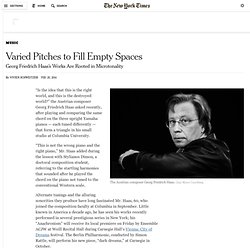
The Austrian composer Georg Friedrich Haas asked recently, after playing and comparing the same chord on the three upright Yamaha pianos — each tuned differently — that form a triangle in his small studio at Columbia University. “This is not the wrong piano and the right piano,” Mr. Haas added during the lesson with Stylianos Dimou, a doctoral composition student, referring to the startling harmonies that sounded after he played the chord on the piano not tuned to the conventional Western scale. George Crumb. Biography[edit] Crumb was born in Charleston, West Virginia, and began to compose at an early age.

He studied music first at the Mason College of Music in Charleston where he received his Bachelor's degree in 1950. He obtained his Master's degree at the University of Illinois at Urbana-Champaign, and then briefly studied in Berlin before returning to the United States to study at the University of Michigan, from which he received his D.M.A. in 1959. Crumb retired from teaching in 1997, though in early 2002 was appointed with David Burge to a joint residency at Arizona State University.
Getting Started With Algorithmic Composition. This page is a quick how to guide to get you started with Algorithmic Composition. Step One: Choose your software Max/MSP You can buy Max/MSP from www.cycling74.com Max is a graphical dataflow language where you connect objects together in a similar manner to a studio patchbay. Price: $399 Platforms: OSX and Windows. HISTORY 204 - THE REACTION AGAINST SERIALISM. 1. Ascendancy of serialism in 1950's -- It was the only show in town - i.e. it was the dominant form of "new music" (except for Cage and a few American crazies) - everything else was "old hat" - Even successful composers like Copland, Britten and Stravinsky gave it a try Reaction against serialism took at least 4 forms: 1.
Texture music - Ligeti, Penderecki. In The Ocean - A Film About The Classical Avant Garde. Influences - Steve Reich. Shaker Loops. For string septet (1978) Shaker Loops was composed in the fall of 1978 using fragments from a string quartet, Wavemaker, written earlier in that year. First performance: December, 1978 in Hellman Hall, San Francisco by the New Music Ensemble of the San Francisco Conservatory, conducted by the composer. The version for string orchestra was made in 1983 and first performed in April of that year at Tully Hall, New York, by the American Composers Orchestra conducted by Michael Tilson Thomas. The original "modular" score, published by Associated Music Publisher, has since been withdrawn and replaced by the 1983 "string orchestra" version. John Cage about silence. Justin Rubin Aleatoric Music. When the intention is to present a traditional score based on procedures involving chance, the composer needs to decide which musical parameters are to be determined through some method of indeterminacy, and what the method itself will entail.
The aforementioned American composer, John Cage, employed a variety of methods, including using characters of the I Ching (an ancient text featuring a series of symbols that relate to Chinese cosmology and philosophy), while the Greek composer Iannis Xenakis (1922-2001) used scientific data compiled by a computer in some of his earlier compositions to provide him with a body of source material (pitches, rhythms, and other parameters) from which he made conscious decisions as to what would go into the final score. One composer/artist, Dick Higgins (1938-1998), even used a machine gun to puncture holes into score paper that he then distributed for performance. 3.
Final Score. Justin Rubin Aleatoric Music. The central question that the composer must ask in terms of live aleatoric music is what parameters of the music need to be defined and to what degree are the materials to be controlled. We will create two original chamber works to explore some ways that this can be answered. 1. Defining Structure Without Specific Materials. Library.music.indiana.edu/tech_s/mla/wgt2cm.txt. Lutoslawski Centenary 2013. Memory.loc.gov/ammem/collections/moldenhauer/2428143.pdf.
Music Theory Online - Phrasing & Articulation. Musica ricercata. Notes on Penderecki. Oblique Strategies: Brian Eno’s Prompts for Overcoming Creative Block, Inspired by John Cage. Of Note: Finale and Sibelius tips and tutorials by musician, arranger and music notation expert Robert Puff. Of Note: Finale and Sibelius tips and tutorials by musician, arranger and music notation expert Robert Puff. Penderecki - Threnody (Animated Score) Pendulum Music. PENDULUM MUSIC / STEVE REICH / 1968. Process music.
Basic rhythm from Clapping Music by Steve Reich, which is played against itself. Reich on Reich. Steve Reich’s Clapping Music. The Experimental Music Yearbook. The Sound of Struggle Tempered With Terror: Penderecki At 80 : Deceptive Cadence. Time unit box system. Tone cluster. User discussion. User discussion. Witold Lutosławski. Earle Brown Music Foundation.
Www.mikesolomon.org/scores/granini.pdf.